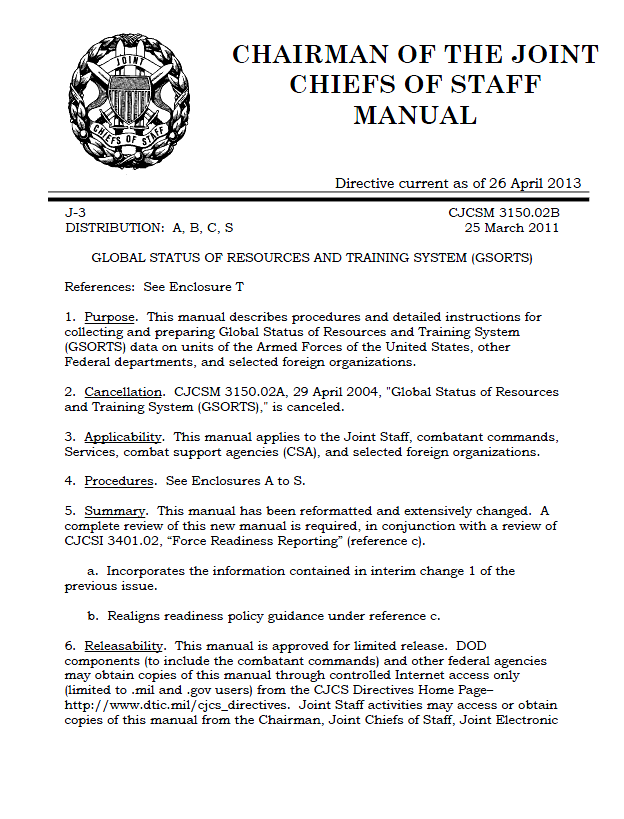The following manual is part of a series of “limited release” DoD doctrine publications that are not released to the public.
CHAIRMAN OF THE JOINT CHIEFS OF STAFF MANUAL CJCSM 3150.02B: GLOBAL STATUS OF RESOURCES AND TRAINING SYSTEM (GSORTS)
- 252 pages
- March 25, 2011
1. Introduction
a. Applicability. This manual provides the information technology (IT) system-level information required to support readiness data entry into GSORTS. The intended audience is the Services, combatant commands, and CSAs to ensure organization unique IT systems (if any) and readiness assessment data meet requirements.
b. Contents. This manual contains GSORTS reporting information. For overarching unit readiness assessment policy guidance refer to reference c.
2. Concept of Operations for GSORTS
a. System Architecture. GSORTS consists of a primary processing site, a network of database sites, and a large number of data providers geographically separated from the processor site.
(1) GSORTS is a mission application of the Global Command and Control System – Joint (GCCS-J) that processes and provides access to GSORTS data. The GSORTS application provides a highly flexible client/server architecture that allows fast, effective data updates, but minimizes contentions for system resources.
(2) In addition, GSORTS provides software applications to simplify data entry, while providing complete and accurate validation capabilities. The endresult is a responsive system that enhances the utility of the data contained within the GSORTS database.
(3) The primary source of data is the registered unit. Other sources include intermediate-level reporting organizations and functional area organizations (e.g., personnel centers, logistic centers).
b. Reporting System
(1) In general, units provide GSORTS assessments to a central site where the data is processed, stored in the database of record, and then made available to decision makers. The central site and measured units exchange data using reports relayed through Defense Switched Network, SECRET Internet Protocol Routing Network (SIPRNET), or a Service- or Defense agency-directed communications media (e.g., secure telephone unit, satellite link, etc.). The processor site is linked via SIPRNET to the database sites and maintains data currency with file transfers over that linkage.
(2) Measured units use one of three possible methods to submit data to the Joint Staff:
(a) Reporting through a service feeder system or using the Readiness Assessment System (RAS) Input Tool (RAS-IT).
(b) Direct submittal to the database via United States Message Text Format (USMTF) GSORTS reports.
(c) Via DRRS-S Current Unit Status (CUS) input tool.
(3) Users may review and analyze GSORTS data directly by using the RAS Output Tool (RAS-OT). Other automated systems access data directly or use extracts of GSORTS data as described below:
(a) Joint Planning System. The Joint Operation Planning and Execution System (JOPES) supports deployment planning and execution of all phases of joint operations. Through an interface at all JOPES sites, JOPES users can access all GSORTS data elements.
(b) Site, Service, and Command-Unique Systems. GSORTS provides data to many systems, to include the Global Command and Control System and Nuclear Planning and Execution System. The specific data provided by GSORTS is tailored to meet the requirements of these systems.
…
2. Concept of Operations for GSORTS
a. System Architecture. GSORTS consists of a primary processing site, a network of database sites, and a large number of data providers geographically separated from the processor site.
(1) GSORTS is a mission application of the Global Command and Control System – Joint (GCCS-J) that processes and provides access to GSORTS data. The GSORTS application provides a highly flexible client/server architecture that allows fast, effective data updates, but minimizes contentions for system resources.
(2) In addition, GSORTS provides software applications to simplify data entry, while providing complete and accurate validation capabilities. The end result is a responsive system that enhances the utility of the data contained within the GSORTS database.
(3) The primary source of data is the registered unit. Other sources include intermediate-level reporting organizations and functional area organizations (e.g., personnel centers, logistic centers).
b. Reporting System
(1) In general, units provide GSORTS assessments to a central site where the data is processed, stored in the database of record, and then made available to decision makers. The central site and measured units exchange data using reports relayed through Defense Switched Network, SECRET Internet Protocol Routing Network (SIPRNET), or a Service- or Defense agency-directed communications media (e.g., secure telephone unit, satellite link, etc.). The processor site is linked via SIPRNET to the database sites and maintains data currency with file transfers over that linkage.
(2) Measured units use one of three possible methods to submit data to the Joint Staff:
(a) Reporting through a service feeder system or using the Readiness Assessment System (RAS) Input Tool (RAS-IT).
(b) Direct submittal to the database via United States Message Text Format (USMTF) GSORTS reports.
(c) Via DRRS-S Current Unit Status (CUS) input tool.
(3) Users may review and analyze GSORTS data directly by using the RAS Output Tool (RAS-OT). Other automated systems access data directly or use extracts of GSORTS data as described below:
(a) Joint Planning System. The Joint Operation Planning and Execution System (JOPES) supports deployment planning and execution of all phases of joint operations. Through an interface at all JOPES sites, JOPES users can access all GSORTS data elements.
(b) Site, Service, and Command-Unique Systems. GSORTS provides data to many systems, to include the Global Command and Control System and Nuclear Planning and Execution System. The specific data provided by GSORTS is tailored to meet the requirements of these systems.

